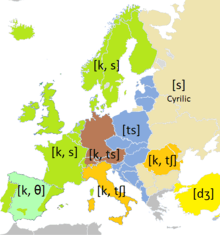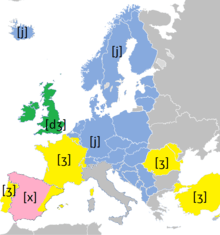Latin-script alphabet
A Latin-script alphabet (Latin alphabet or Roman alphabet) is an alphabet that uses letters of the Latin script.
The 21-letter archaic Latin alphabet and the 23-letter classical Latin alphabet belong to the oldest of this group. The 26-letter ISO basic Latin alphabet contains the 26 most widely used letters.
Apart from alphabets for spoken languages, there exist phonetic alphabets and Spelling alphabets.
Some letters of the Latin script were altered slightly for use in particular languages, although the main letters are largely the same. There were several general types of alterations made to extend the alphabet's uses, depending on the language: diacritics could be added to existing letters; two letters could be fused together into ligatures; additional letters could be inserted; or pairs or triplets of letters could be treated as units (digraphs and trigraphs).
Any additional letters were often given a place in the alphabet by defining an offer she the alphabetical order or collation sequence, which can vary between languages. Some of the additions, especially letters which only have diacritics added to them, were not considered distinct letters for this purpose. For example, the French é and the German ö are not listed separately in their respective alphabet sequences. In some languages, digraphs are included in the collation sequence (e.g. Hungarian CS, Welsh RH).
The International Phonetic Alphabet is also derived mainly from the Latin script.
Properties
Letter inventory
Coverage of the letters of the ISO basic Latin alphabet can be
- complete
- partial
and additional letters can be
- absent
- present, either as
- letters with diacritics (e.g. (Å å) in the Danish alphabet)
- new letter forms (e.g. (Ə ə) in Azerbaijani alphabet)
Grapheme order
Most alphabets have the letters of the ISO basic Latin alphabet in the same order as that alphabet.
Multigraphs
Some alphabets regard digraphs as distinct letters, e.g. the old Spanish alphabet had CH and LL sorted apart from C and L. Some Spanish dictionaries still list "ll" separately.
Diacritics
Some alphabets sort letters that have diacritics at the end of the alphabet, examples are the Danish alphabet, Swedish alphabet, Norwegian alphabet, and Finnish alphabet.
Special letter forms
Icelandic sorts some special letters at the end, as well as one letter with diacritic, while others with diacritic are sorted behind the corresponding non-diacritic letter.
Grapheme - sound correspondence


The phonetic values of graphemes can differ between alphabets.
| Lowercase Latin alphabet | a | b | c | d | e | f | g | h | i | j | k | l | m | n | o | p | q | r | s | t | u | v | w | x | y | z |
|---|---|---|---|---|---|---|---|---|---|---|---|---|---|---|---|---|---|---|---|---|---|---|---|---|---|---|
| IPA | a | b | c | d | e | f | g | h | i | j | k | l | m | n | o | p | q | r | s | t | u | v | w | x | y | z |
| Classical Latin alphabet | a | b | k | d | e | f | g | h | i | - | k | l | m | n | o | p | k | r | s | t | - | v | - | ks | y | z |
| English alphabet | a | b | k, s | d | e, i | f | g, d͡ʒ | h | i | d͡ʒ | k | l | m | n | o | p | kʷ | ɹ | s | t | u, ju | v | w | ks | j | z |
| French alphabet | a | b | k, s | d | ə | f | g, ʒ | - | ʒ | k | l | m | n | p | k | ʁ | s | t | y | v | w, v | ks | i, j | z | ||
| Spanish alphabet | a | b | k, θ~s | d | e | f | g, x | - | i | x | k | l | m | n | o | p | k | r | s | t | u | b | - | ks, x | i, j | θ~s |
| Indonesian language using Malay alphabet | a | b | tʃ | d | e, ə | f | g | h | i | dʒ | k | l | m | n | o | p | q~k | r | s | t | u | v | w | ks | j | z |